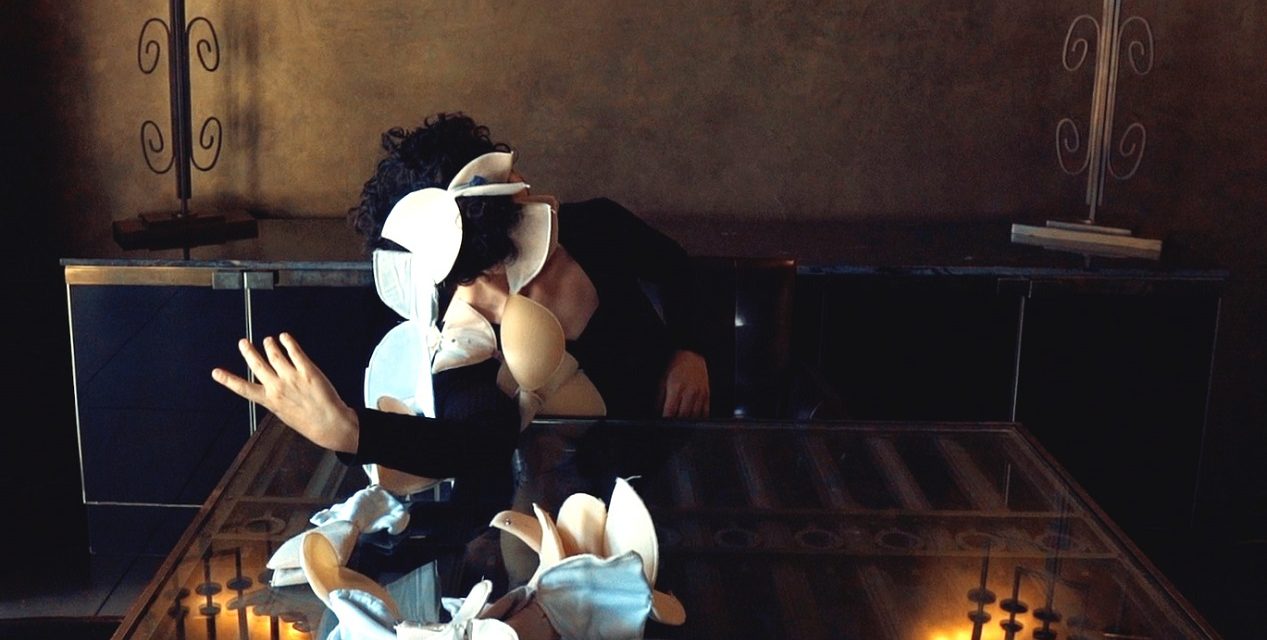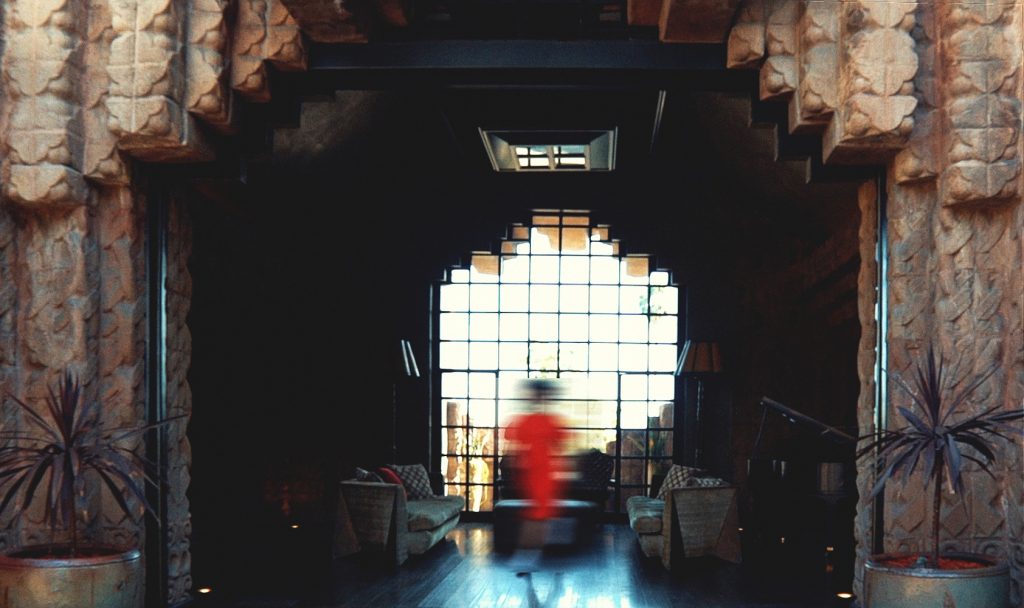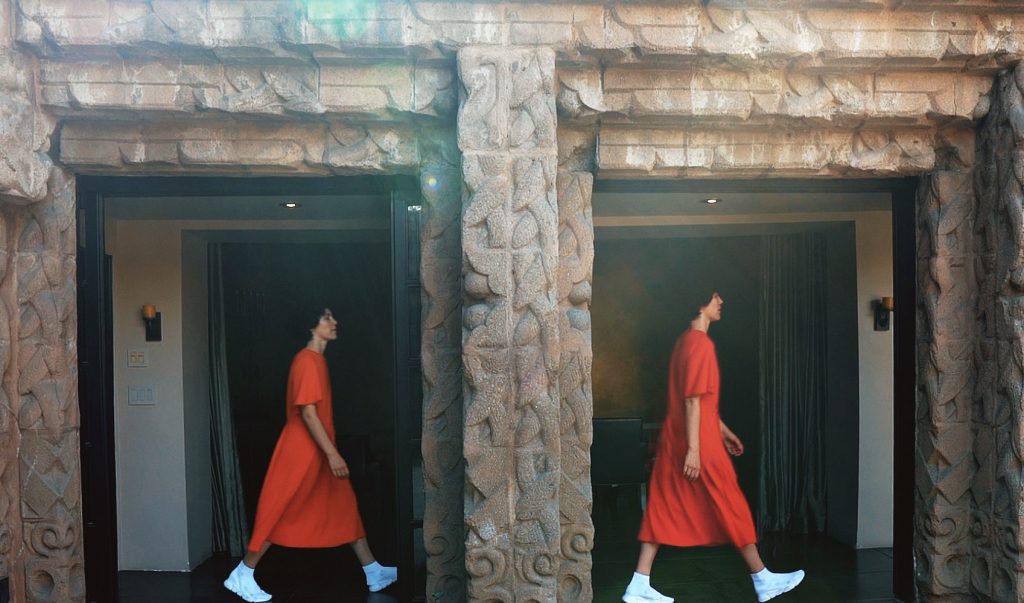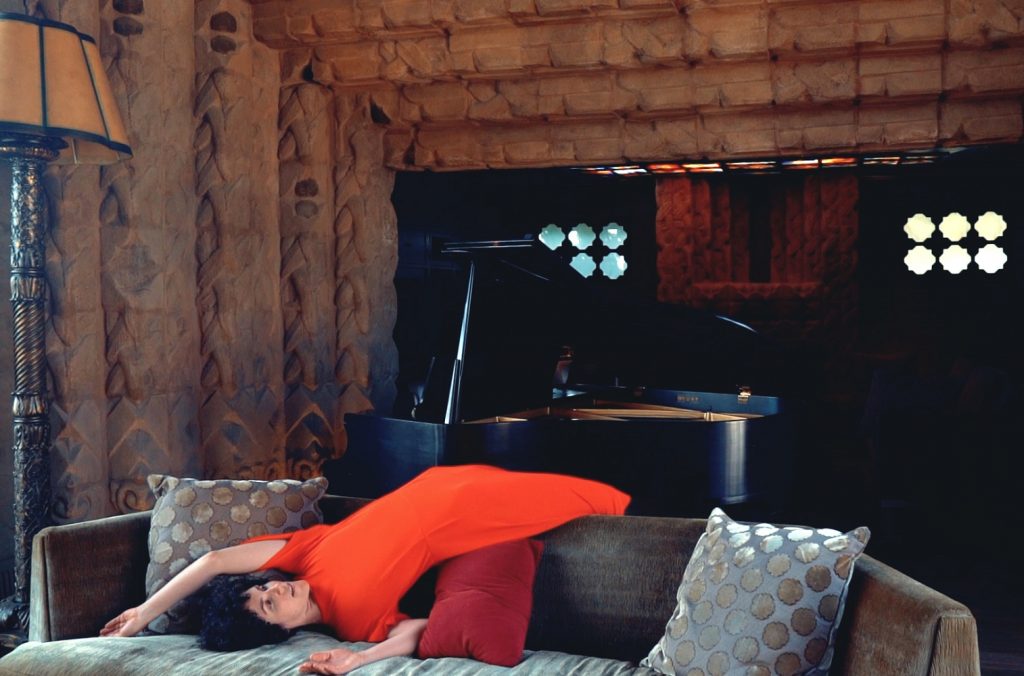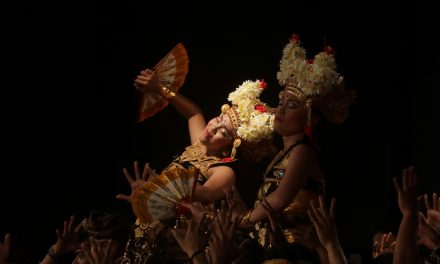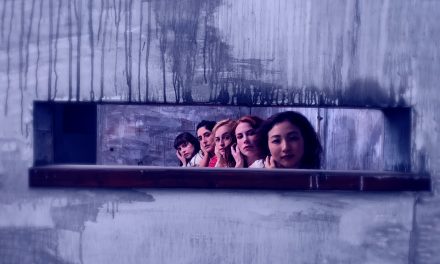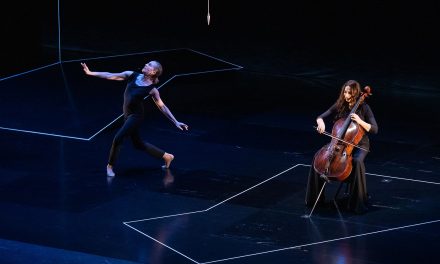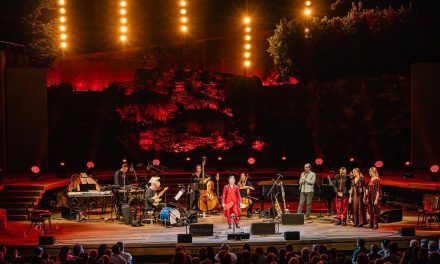Nestled within LA’s Los Feliz neighborhood right along the Hollywood border sits the John Sowden House. Towering above Franklin Ave., architect Lloyd Wright (son of the famous Frank Lloyd Wright)’s building is hard to miss, with its giant textile blocks arching over the doorway and large street-facing window like a double crown. Within, dark secrets create an enigmatic presence which Rebecca Bruno’s company, homeLA, in conjunction with other artists, taps into through a variety of mediums, primarily dance and performance art. The 15 ongoing and timed pieces create PASSAGES that fluidly unite the stories of the many residents and people passing through the home’s history over the years.
Upon climbing the stairs and preparing to enter the house at 4pm on Sunday, January 13, a strange-looking figure was seen clambering up the property’s upward-sloping lawn, shouting oddities at the gathering crowd: “The museum will be open 24 hours today!” His bright, glittery eye makeup, feathered costume and trailing stuffed penguin (Yolanda) on a leash, whom he had dressed as a showgirl served as an introduction to the various spirits and situations awaiting the audience inside. Though he was the most eccentric of the bunch, the character was among the ones most closely based on a real person—experimental, underground filmmaker Jack Smith.
As explained by pamphlets scattered throughout the house titled “WAIT FOR ME AT THE BOTTOM OF THE POOL OR JACK GOES HOLLYWOOD” (which is also the name of this ongoing performance and in part, the real-life Smith’s book of writings), Jack Smith was never a resident of the home. But his spirit somehow feels connected to the Sowden House. Performer Tyler Matthew Oyer’s hilarious portrayal made his inclusion very natural. In a later scene, which took place in the courtyard, Oyer recited pieces of Smith’s life while slinking around the spectators and toward the pool, his low, comic voice sounding faraway as he reared his head around to make eye contact with the amused audience members gathered around him. Oyer primarily talked about Smith’s number one obsession—Dominican actress and “Queen of Technicolor”, Maria Montez, whose life ended in 1951 when she drowned in her bathtub due to a heart attack at age 39. Yolanda was placed on a giant lobster floaty, thereby surviving her encounter with the sinister-seeming pool as Jack continued to ramble about his fascination with exotic Polynesian culture, and all things Hollywood in a self-mocking tone. His fixation with Tinseltown echoes our own—the main reason why this show drew so much attention in the first place.
Tying in to Montez’s untimely death was a dance coordinated by Zaquia Mahler Salinas called “Rest”, which featured Lauren Christie performing to subtle music by James Carter arranged/performed by Jonny Tarr. Her steps were delicate and controlled as she emerged from within one of the rooms, making her way toward the pool. She kept in constant motion as she skirted around the edge, choosing whether she wanted to step inside before finally giving in and peeling her clothes off until only left wearing a small black slip. She placed one foot into the cold water, slowly moving the rest of her body into it until finally sinking downward, emerging herself completely to “rest” or drown within. Although her story was reminiscent of Maria Montez’s, Christie’s general look reminded one of the house’s most famous victim and temporary guest—the Black Dahlia, who was thought to have been murdered in the Sowden House in 1947 by Dr. George Hodel, who lived there from 1940 through 1950. His son, former homicide detective Steve Hodel, theorizes that the doctor butchered the 22-year-old Elizabeth Short on the property before moving her to the outdoor location where her body was later found in pieces. The basement, where it is thought the deed took place, was not open to the public during the performances.
First built by Lloyd in 1926, the now-landmark was meant to be an entertainment center for painter and photographer John Sowden after whom the house was named. The rectangular courtyard located at the heart of the home was essentially built to be a large stage. Current owners Jenny Landers and Dan Goldfarb chose to honor this feature by contacting Bruno and homeLA in order to set up the show. As more visitors poured into the home, they easily found their way to the comfy couches laid out within the indoor/outdoor den and living room, and along wicker chairs dotting the edges of the pool and spa, which were added in 2001 when much of the house was remodeled. Most of the home, including the kitchen, has open access to the courtyard, which made it difficult to find a bad seat as the rest of the performances unfolded throughout the course of Saturday and Sunday’s three-hour show.
Water is a central theme throughout both the architecture of the house and many of the pieces. This, along with the torches located by the pool, and the large fire pit burning over a base of glimmering emerald and jade stones, was the inspiration for the food and drink served in the evening. Curated by Emily Marchand,” earth absorbs water” as the refreshments were called, was made up of ingredients based on native plants found in the Americas. Offerings of potato chips and “horny bulls”, which is tequila (Corralejo in this case) mixed with orange juice, were laid out in the dining room and on floating tablets within the jacuzzi in the master bathroom.
Similarly stimulated by the water and the continuous interactive flow of the home is Mak Kern’s kinetic sculpture “Above Below and Within”, a large mobile emerging from within the pool. Passers-by would push its bronze arms out of their way as they walked past it, causing the moons dangling off its edges to spin, its movement constantly drawing the audience’s eyes to the courtyard.
Other performances to take place along the perimeter of the pool, included Cheng-Chieh Yu’s “Inservient” and Bruno’s “WEFT”—two pieces that were radically different from one another, but equally powerful.
“Inservient” was an ongoing work featuring three flapper girls who moved like Fates around the property with permanently morbid expressions. Their consistent appearing and disappearing in different places around the home at random times, made their presence feel eternal. Yu, Sarah Jacobs and Darrian O’Reilly evoked death and all its temptations as they lured people into the house with their initial performance on the narrow steps leading up to the second-floor living quarters. The threesome maneuvered themselves on the staircase, partially blocking the entrance as they filmed one another reeling back slowly in deep thought and movement. This only allowed a certain number of guests in at a time and almost served as a warning not to proceed, while cleverly enticing viewers to stay. Their clothing, which was from the era the house was built in and contrasting obsession with modern technology further enhanced their other-worldly qualities.
Once the beings let you up the stairs and into the party, they stayed with you as they appear on a television screen by the fireplace featuring videographer Jingqiu Guan’s movie of Dennis Ramirez fixing their hair and makeup, thereby breaking the fourth wall as they allowed visitors a peek into their preparations. At one point, they took over the aquarium room, twice performing a scene during which they filmed one another moving along the fish glass and writing on the floor. Entrance to the room was barred as they perform, but audience members were encouraged to look through the door’s windows in order to watch at a distance. Later they appeared by the pool, walking out in a single file and peering within the water’s depth, leaning forward as though relishing the thought of suicide before dismissing it and walking away. Their performance finally culminated in a final interaction with the spa—Yu was perched like a crab around the its edge, posing with a large piece of black cardboard which was missing strip through which she stuck an arm, then a leg and finally her head, inching closer to the jacuzzi as her comrades recorded her. Just when it looked as though she were going to allow herself to fall in, she stepped backward, ending the dance as the three bowed, surviving the encounter before deciding to no longer visibly haunt the house
“WEFT” on the other hand seemed like a happier piece, only due to Sam Widaman’s bouncy music and the brightly colored costumes made by Lynn Ellen Bathke, which were inspired by the swirling neutrals and translucent greens and blues found all along the house. Performed twice, Bruno and Flora Wiegmann mirrored one another’s sweeping motions as they made their way down one of the open corridors flanking the courtyard. Once in the living room, they each grabbed angled sculptures (made by Bruno) that look like silhouetted blueprints of the home, which they thrusted, shook and raised high above the cream-colored, Aztec-tiered crowns of cloth that partially hid their faces. The dance continued with sharp shifts, rigid turns and neat hops along the sides of the pool, before concluding upon the deck located below a giant screen found at the back of the house, parallel to the beautifully balconied window seen from the street. The two were architecture come to life, pulling from the home’s shapes and design to emphasize Snowden House’s personality—a character all its own.
Over the years, homeLA’s pieces have become more technologically-involved. For PASSAGES homeLA collaborated with digital designer PARADEUX and founder Delaram Pourábdi to create four videos. “POETRY IN MOTION”, featured on a large screen in the rear of the house, looped continuously and added a mystical, outer-spacey element to the show that tied in especially well with Kern’s sculpture. The illustrations took on a galaxy theme that used stars to create faces, which later exploded into shards of light for a philosophical representation of fleeting life. Another was “D E U X”, projected onto a wall located in the Master Bathroom above a koi pond. The movie featured Bruno continuously falling and floating over the ottoman inside the walk-in closet located directly across from it, and played with the concepts of reflection and duality, especially as multiple images of Bruno exploring alternate positions within the space flooded the film. “PASSAGES” was the final piece to be shown that evening. It showcased Bruno moving similarly, in her unique style, along the outside of the house and through nooks and crannies not directly in use or identifiable during the day-to-nighttime performances, as a way to ensure an absolute incorporation and recognition of every inch of the property and the transitions that could be formed through the space, while music by Yann Novak played overhead. Just before that was a contradictory short film labeled “forget” by Salinas (the only film, aside from the “Inservient”’s hair/makeup tutorial, to be made without PARADEUX). It consisted of a short clip of Sandra Ruiz moving along to a score by Geminelle Rollins from Salinas’ introspective film The Loneliest Part of Here is Now. The title is self-explanatory and tied into Bruno’s collaborative piece with Pourábdi well.
The smoothest combination of dance and videos was “GO AWAY, COME CLOSER” (another collaboration with PARADEUX), which also used juxtaposition to compare the polarizing emotions evoked by the home—curiosity and disillusion. Located in the green room, a film portrayed black-and-white imagery of dancer Kenzie McClure interacting with nature on LA’s cliffs and hills. The room’s floor was bare and covered in a foil-like substance with only a chair and book located along the back wall. Above it, questions and statements about power and life were projected while a voiceover echoed the same concepts, and the video appeared along the side wall to an avant-garde soundtrack by Alan Watts, remixed by Pourábdi. Twice throughout the evening, the film was joined by McClure who performed a live version of some of the dancing seen in her videos—vulnerability became a large part of her movement as she rolled on the floor, disrupting the foil below her before taking charge, reeling upward and sitting on the chair only to slide off of it once more and repeat the cycle. Her number was a never-ending battle, like the continuous tragedy that had befallen some of the other characters present in the house.
Two of the most powerful performances included dancer/vocalist Odeya Nini’s “The Corridor Between”, and choreographer/performer Crystal Sepúlveda’s “Rooting Within”. During the short lulls in between, major center stage performances and while ongoing works were on their second or third run, music filled the living room of the Sowden House thanks to harpist Low Leaf, and guitarist TT (Theresa Wayman) of indie group Warpaint. They sang modern songs about love and loss—an underlying theme in much of the evening’s work (Saturday’s show featured artist vōx instead of Wayman). As the musicians were halfway through their sets, a sharp piercing “ooooooo” was heard emerging from the stairwell. Drawing a small crowd purely with the power of her voice, Nini’s canto evoked a deep banshee-like spirit, which took over the dark corridor and seemed to channel spirits from beyond the grave to whom she gave a voice through her singing. Low, continuous notes, an electronic voicebox manipulator, and Nini’s red dress and serious expression created a fiery, almost angry vibe. She shone a laser pointer at the crowd’s chest, coming in close enough to physically touch the spectators every time, isolating each audience member as though questioning their presence in her space. Her final smile and bow were reassuring and her singular performance alarmingly moving.
“Rooting Within” took place along the façade of the house and involved a very visibly pregnant Sepúlveda moving along the entry stairs and up the small hills within which the Sowden House is nestled. Her agility was incredible, and the careful cradling of her stomach as she maneuvered down the tiled steps tied in motherhood—a completely unexpected force—into the many layers of the Sowden House. Sepúlveda’s choice to represent the home as “an evolving womb punctuated by obscure visibility and scale” while connecting her character to the Taíno fertility goddess Atabey was unique and unforgettable. Often said to resemble a Mayan temple, the architecture made a direct connection with the indigenous culture that influenced its appearance and was personified as a woman giving birth to the fascinating stories that have added to Hollywood’s lore and LA’s fascination with the home over the years. Fruit offerings made within a small, inactive water fountain just below the stairwell completed Sepúlveda’s design.
The 15 pieces showcased every side and angle imaginable of the Sowden House, weaving a tale of history and perspective that united the many artists’ personal visions and interpretations of a home built up to legendary heights by the locals thanks to the deeds of its owners. Attracting visitors from all walks of life, mixing modern with old, and creating a story with no traditional elements to it, but which remains classic Hollywood is a feat that must be honored and recognized. homeLA’s PASSAGES went far beyond doing the Sowden House justice with their unforgettable weekend of constant movement—a production that was as rich and valuable as the home itself.
For more information about homeLA, click here.
For more information on Sowden House, click here.
Featured image: film still of PASSAGES by Delaram Pourábdi of PARADEUXand Rebecca Bruno

